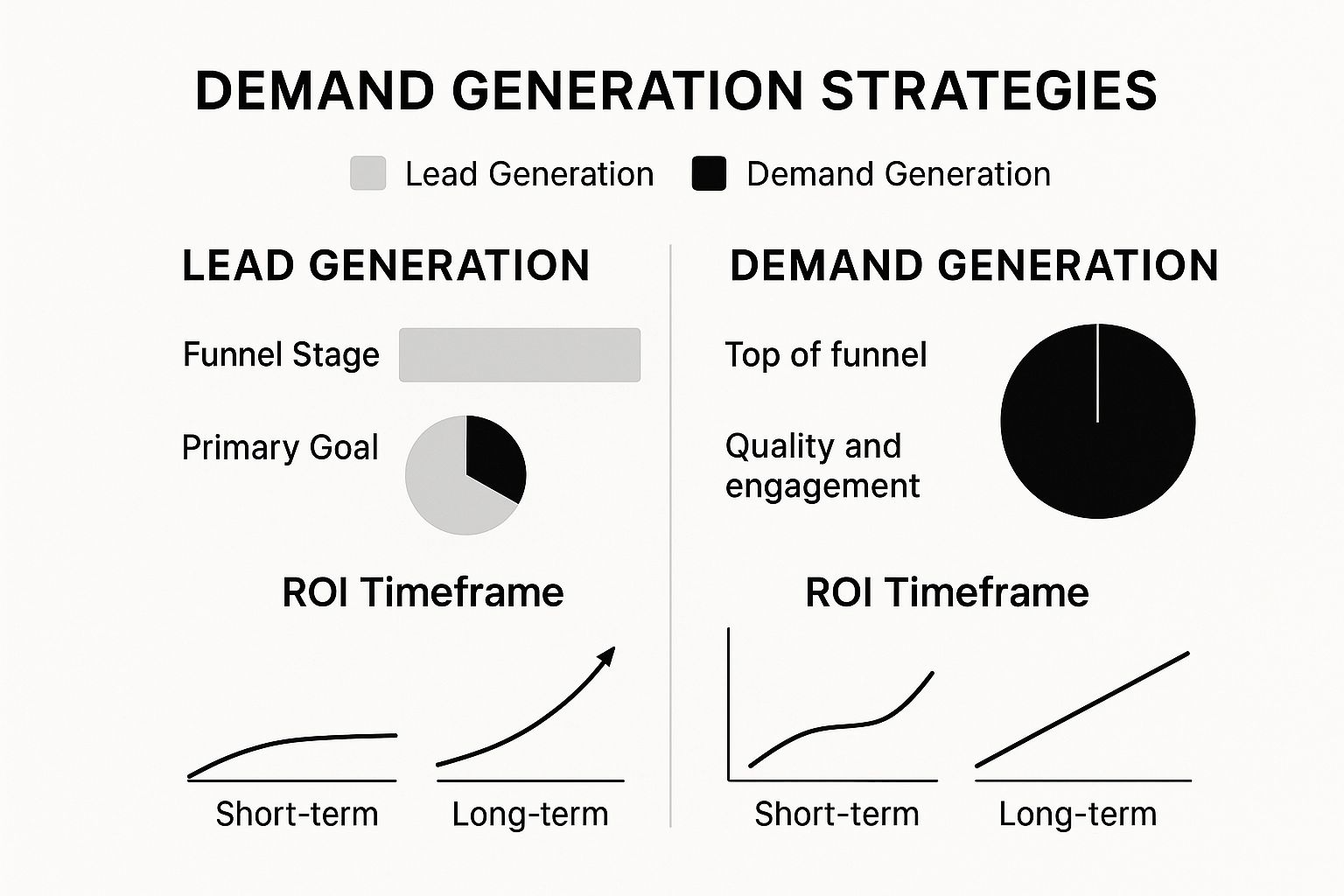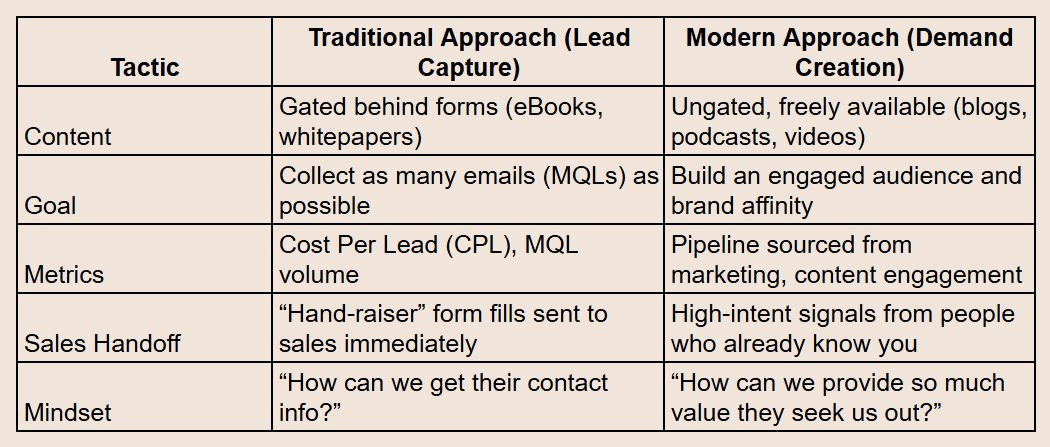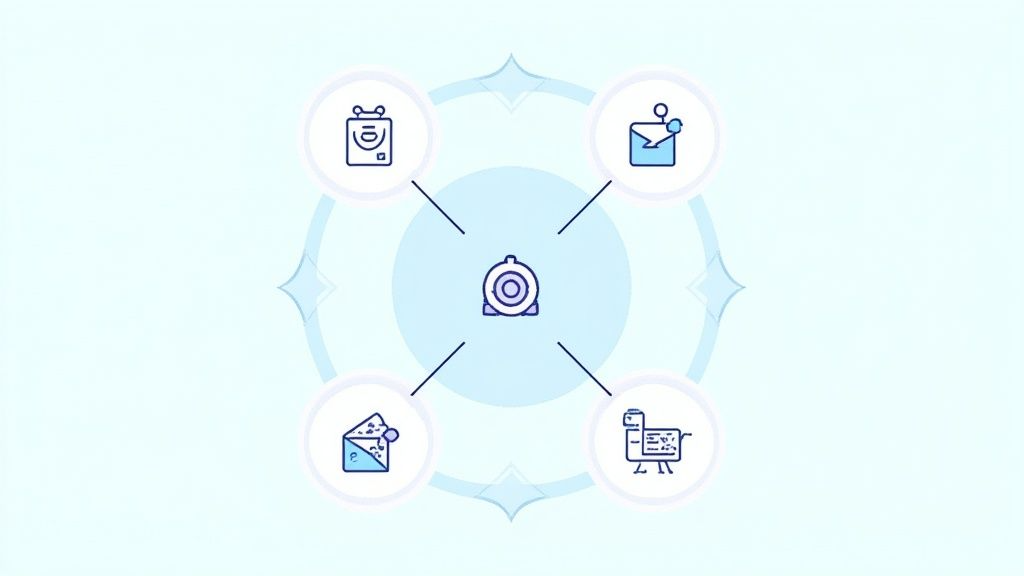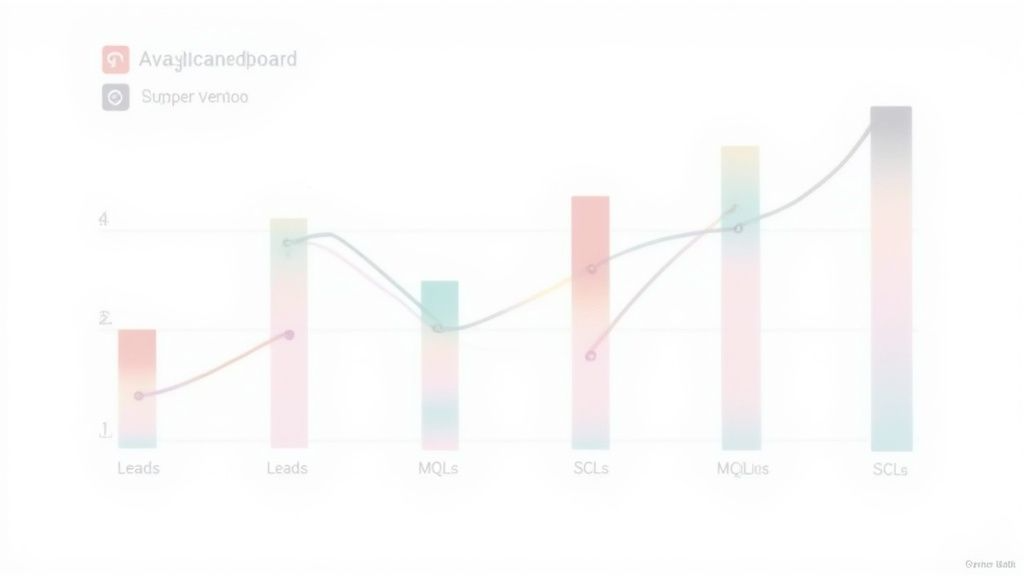A modern B2B demand generation strategy is all about a fundamental shift in thinking. It’s about moving away from chasing the tiny slice of your market that’s ready to buy right now and instead, creating demand across your entire industry.
The goal? To become the go-to resource. The trusted authority. When your ideal customer finally has a problem that needs solving, your company is the first, and only, one they think of.
Shifting Your B2B Demand Generation Mindset
Let's be honest: the old B2B playbook is completely broken. Gating every piece of content and obsessing over Marketing Qualified Leads (MQLs) just doesn't build the genuine relationships you need for real, long-term growth.
The hard truth is that only about 3-5% of your target market is actively looking to buy at any given moment. If you focus all your energy there, you’re just throwing money into a hyper-competitive cage match with everyone else for the same small piece of the pie.
A winning B2B demand generation strategy isn’t about interrupting people; it’s about attracting them. You do this by becoming the host of the conversation in your niche. This takes a real mindset shift, moving from a transactional, lead-focused model to one built on authority and generosity.
From Lead Capture To Demand Creation
The real magic happens when you move from simply capturing existing demand to actively creating new demand. What does that look like in practice? It means giving away your best ideas and insights for free to build a loyal audience.
When you consistently deliver value without asking for anything in return, you become the trusted expert. People start seeking you out.
This image really drives home the difference between a traditional lead-gen focus and a modern demand-gen approach.

As you can see, demand generation is a long game. It prioritizes deep engagement and quality over short-term lead volume, which is how you build a pipeline that actually lasts.
To see this distinction in more detail, let's break down the tactics side-by-side.
Traditional Lead Gen vs Modern Demand Gen

The table makes it clear: the modern approach isn't about harvesting contacts. It's about cultivating a following that wants to do business with you when the time is right.
"Demand generation is about being in front of your target market before they know they need you. So when they’re ready to buy, they come to you, not your competitors."
This long-game strategy ensures that when a prospect’s needs finally click into place, your brand is already top of mind. For some teams, this shift might mean bringing in outside help to speed things up; you can explore the benefits of outsourcing lead generation to see if it fits. To dive even deeper, check out these other top B2B demand generation strategies and see how this mindset plays out in the real world.
Building Your Foundation with Audience Insights
Before you can build any sort of effective B2B demand generation strategy, you have to know exactly who you’re talking to. I'm not talking about those generic, surface-level personas with vague job titles and company sizes that end up gathering dust in a shared drive. Real demand creation is built on a deep, almost empathetic understanding of your audience’s actual challenges, what really motivates them, and the triggers that make them act.
The good news? The foundation for this understanding is already in your possession. It’s your first-party data, the information you've collected directly from your audience and customers. It's your single most valuable asset. Forget the guessing games; the answers are sitting right there in your systems.

Uncovering Insights from Your Existing Data
Your journey to truly understanding your audience starts with the data you already have. This is where you move from making assumptions to building evidence-based profiles that show you how your best customers actually behave.
I always start by digging into three key sources:
- Your CRM: Who are your best customers? Seriously, pull a list. Look for common threads in their journey, the specific problems they were trying to solve when they came to you, and the exact language they used in sales calls.
- Website Analytics: Which pages are your hottest prospects visiting? What blog posts or resources are they spending the most time on? This behavior tells you exactly what they care about and what questions they're trying to answer right now.
- Customer Conversations: Get your hands on sales call recordings and support tickets. The raw, unfiltered voice of your customer is an absolute goldmine for understanding their real pain points, objections, and what they hope to achieve.
The goal here is to build rich, behavior-based profiles. Forget basic demographics. This is about uncovering the specific questions your buyers are asking and the triggers that push them to take action.
This data-first approach isn't just a "nice-to-have", it's a game-changer. Companies that get serious about their first-party data have reported a doubling of conversion rates and a 30% drop in customer acquisition costs. It also leads to a roughly 50% improvement in audience segmentation, which lets you create hyper-relevant content that resonates at every single stage of their journey. You can discover more insights on how first-party data is reshaping B2B marketing here.
From Data to Actionable Strategy
Once you've collected all these little nuggets of insight, you can finally translate them into a content plan that actually works. Instead of creating content about what you think is important, you can now build things that directly address the documented needs of your ideal customers.
For instance, if you see a pattern where prospects are constantly asking how your software integrates with a specific tool, that’s your signal. That's your cue to create a detailed guide, host a webinar, or record a podcast episode on that exact topic.
This simple shift ensures every piece of content you create provides genuine value, builds trust, and lays a rock-solid foundation for sustainable growth.
Hosting the Conversation with a B2B Podcast

Once you’ve got those deep audience insights, the next move in a modern b2b demand generation strategy is to stop shouting at your market and start hosting the conversation within it.
Forget the gated ebooks and the cold outreach for a minute. The single most powerful way to forge a real, human connection with your audience today is by launching a B2B podcast.
A podcast is so much more than just another top-of-funnel content asset. It's a high-affinity, bottom-of-the-funnel engine for building profound trust. Think about it: when someone tunes in and gives you 30-45 minutes of their time, directly in their headphones, they're offering you their undivided attention.
This intimate format creates a level of likeability and authority that a blog post or social media update just can't touch.
Giving Away Your Best Ideas
The real magic of a successful B2B podcast is generosity. You have to be willing to give away your best ideas for free, no strings attached.
By hosting insightful conversations with industry experts, customers, and even friendly competitors, you create immense value for your target audience long before they ever think about buying.
This strategy nails several critical goals at once:
- It positions your brand as the central hub in your industry, the go-to source for reliable information.
- It builds powerful strategic relationships with guests who often have their own influential networks, massively extending your reach.
- It creates an evergreen library of authoritative content that consistently attracts your ideal customers over time.
"The whole game is to give your best stuff away for free... You want to be the person that when someone has a problem, you are the first person or company they think of, and you can only do that by consistently providing value over time." - Tom Hunt, Founder of Fame.
This approach ensures that when your ideal customer is finally ready to buy, your company is the only one they seriously consider. You've already done the hard work of earning their trust.
From Channel to Ecosystem Core
The key is to stop thinking of your podcast as just another marketing channel and start seeing it as the core of your entire demand generation ecosystem.
Each episode is a content goldmine. A single conversation can be sliced and diced into dozens of assets, social media clips, detailed blog posts, newsletter highlights, and quote graphics. One recording session can fuel a multi-channel campaign that surrounds your audience with value.
This creates a powerful flywheel effect where your podcast fuels all other marketing activities, attracting and engaging your ideal customers around the clock. If you really want to dig into how to grow your listenership, check out these essential B2B podcast audience development strategies.
Smart Distribution: Turning Listeners Into Pipeline
Recording a killer podcast is a huge win, but let's be honest, it's only half the job.
The real magic happens when you get that conversation in front of the right people, over and over, on the platforms they already live on. This is where smart distribution turns your audio file into a genuine pipeline-generating machine. It’s the difference between a hobby and a core part of your B2B demand generation strategy.
What this really means is treating every single episode like its own multi-channel campaign. One great conversation can fuel your entire marketing engine for weeks. The trick is to slice and dice the core ideas into different formats that feel native to the channels where your audience is already scrolling.
Turn One Episode into a Full-Blown Campaign
Please, don't just let your episodes collect dust in a podcast player. A single recording is an absolute goldmine of content waiting to be repurposed. Your goal is to surround your ideal customers with valuable insights from that core conversation until they can't ignore you.
Here's a simple, practical blueprint we use:
- Create Engaging Social Snippets: We pull the most powerful, punchy moments from an episode and turn them into short video clips or audiograms. These are absolute dynamite for platforms like LinkedIn, grabbing attention mid-scroll and pulling people back to the full episode.
- Write SEO-Optimized Blog Posts: The episode transcript is your best friend here. We turn the key themes and takeaways into a detailed blog post. This gives people a way to consume the content by reading, but more importantly, it starts capturing organic search traffic from people actively looking for answers you've provided.
- Send a Value-Packed Newsletter: Share the best takeaways, a couple of killer quotes, and a direct link to the episode in your next email newsletter. This is perfect for nurturing the audience you already have and keeping them locked in.
The core idea is simple: create the content once, then distribute it forever. By atomizing a single podcast episode, you create dozens of touchpoints that hammer home your expertise and keep your brand impossible to forget.
This isn’t about just posting randomly; it’s a system for consistent message delivery. You can go way deeper on building out a promotion plan by digging into these proven content distribution strategies.
Integrated Services for Maximum Reach
Look, executing a multi-channel plan like this takes time, and it requires some very specific skills. This is exactly where integrated services can come in and amplify your message without creating a ton of extra work for your team.
For example, a dedicated B2B Social Media Agency can take ownership of creating and promoting all those social snippets, making sure they actually hit your ideal customer profile on LinkedIn. In the same way, a B2B Email Newsletter Agency can expertly craft the emails that drive your most loyal followers to listen to every new episode.
When you pair your core podcast content with specialized distribution services, you're not just promoting, you're building a powerful, integrated system. This ensures your hard-won insights consistently find your target audience on the platforms they already trust, turning passive listeners into real, active prospects.
Using AI to Scale Your Content Engine

If you want to scale your demand gen program without the quality dropping off a cliff, you have to get smart with technology. This is where AI stops being a buzzword and becomes a real, practical part of your b2b demand generation strategy, especially if you're running a podcast-centric content workflow.
The point isn't to replace your team's creative spark. It's about augmenting it. Let AI handle the tedious, data-heavy lifting. That frees up your people to focus on the big picture strategy and, more importantly, build real relationships with your audience and guests.
Augmenting Your Podcast Workflow
Think of AI as a hyper-efficient assistant for your podcasting engine. It can chew through audience data to tell you what topics are trending or what questions keep popping up, making sure your content is always hitting the mark.
Here’s how you can actually put it to work:
- Personalized Guest Outreach: Ditch the generic templates. AI can help you draft highly personalized outreach emails by quickly summarizing a potential guest's recent work or social media chatter. It’s a game-changer for getting replies.
- Efficient Asset Creation: Tools can now spit out accurate transcripts in minutes. From that single file, you can rapidly create SEO-optimized blog posts, social media captions, and newsletter snippets. One episode, a dozen pieces of content.
- Topic and Trend Analysis: Let AI scan industry conversations and what your competitors are talking about. It can flag episode topics that have a high chance of resonating with your ideal customer profile before you even hit record.
AI should supercharge your team, not replace it. By automating the grunt work of content repurposing and data analysis, you give your team more time to think strategically about how to create value for your audience.
Starting Small and Scaling Smart
The secret to getting this right is to start with small, measurable pilot programs. Don't try to rip and replace your entire workflow overnight. That's a recipe for disaster.
Instead, pick one specific pain point, like writing show notes or creating social clips, and test a tool to solve it. Once you can prove it's saving time or improving results, you can scale what's working.
This approach is also how you get better targeting and faster results. AI tools can analyze huge sets of customer data in real time, uncovering buying signals and predicting demand trends with surprising accuracy. This means you can deliver the right content at the exact moment a prospect is leaning in, which can seriously boost your conversion rates. You can dig deeper into how AI is shaping future demand generation trends on my-outreach.com.
By using AI to scale the tactical side of your content strategy, you're not just doing more, you're building a smarter, more efficient demand gen engine.
Measuring What Actually Matters for Growth
So, how do you actually prove the ROI of a B2B demand generation strategy that’s built on brand, trust, and giving away your best ideas?
The answer is surprisingly simple: you stop tracking vanity metrics that make you feel good but don't actually move the needle.
Let's be honest, leadership doesn't really care about Marketing Qualified Leads (MQLs) or the number of PDF downloads. They care about business outcomes. That means your measurement framework has to tie your marketing activities directly to revenue.
Instead of getting bogged down in all the top-of-funnel noise, it’s time to zero in on the key performance indicators that truly show growth and efficiency.
Shifting to Business-Centric KPIs
If you want to prove the real-world impact of your efforts, your dashboard needs to tell a clear story about pipeline health and business growth.
Your new focus should be on metrics like these:
- Pipeline Velocity: How quickly are deals moving from that first touchpoint to closed-won? A faster velocity is a huge signal that you're attracting higher-quality, better-educated prospects.
- Sales Cycle Length: Is your content-driven approach actually shortening the time it takes to close a deal? When prospects show up already trusting you, the sales process naturally speeds up.
- Customer Acquisition Cost (CAC): A killer demand gen program should be attracting high-intent buyers. Over time, this leads to a more efficient sales process and a lower CAC. It just makes sense.
- Revenue Influenced by Content: This one is absolutely critical. You need a way to show how many deals were directly touched or influenced by your podcast, blog, or social content.
The best feedback loop isn't always a dashboard. It’s when your sales team starts saying things like, "Oh yeah, another prospect told me they listen to our podcast all the time." That’s the qualitative proof that you’ve built real brand affinity, and it's gold.
Tracking Qualitative Signals
Not everything that counts can be counted. The qualitative signals are just as important, sometimes more so, for showing that your brand is becoming the go-to authority in your space.
These are the moments that tell you the strategy is resonating on a much deeper level than a click or a download ever could. To really connect the dots, you need a solid framework for measuring B2B podcast ROI that combines hard numbers with these powerful, story-driven insights.
Your B2B Demand Generation Questions Answered
We've covered a lot of ground on building a modern B2B demand gen strategy from the ground up. But I know there are always a few lingering questions, especially when it comes to folding in a powerful tool like podcasting.
Let's tackle some of the most common ones I hear.
What are the benefits of investing in B2B podcast promotion?
Investing in B2B podcast promotion transforms your show from a piece of content into a strategic business asset. The primary benefits include establishing industry authority, creating deep audience engagement through an intimate format, and building a loyal follower base that trusts your brand. This directly translates to increased brand visibility and generates a library of repurposable content that can fuel all other marketing channels, ultimately nurturing high-intent leads for your sales pipeline.
What are effective B2B podcast promotion strategies?
Effective B2B podcast promotion strategies focus on multi-channel distribution to meet your audience where they are. Key tactics include creating short video/audio clips for social media (especially LinkedIn), collaborating with guests for cross-promotion to their networks, and featuring episodes in your email newsletter. A crucial strategy is repurposing each episode into an SEO-optimized blog post to capture long-term organic traffic. Comprehensive audience growth also involves paid promotion and engaging with relevant online communities to share valuable insights from your show.
How can podcast marketing services boost our company's visibility?
Podcast marketing services act as a force multiplier for your content, boosting company visibility by implementing professional, scalable promotion systems. These services handle everything from audiogram and video clip creation to strategic distribution across social media, email, and other relevant platforms. By leveraging their expertise in audience growth and content repurposing, they ensure your podcast reaches a much wider, more targeted audience than you could achieve alone, solidifying your brand's presence and authority in the market.
What packages do B2B podcast promotion services typically offer?
B2B podcast promotion services typically offer tiered packages based on the scope of work. Common offerings include a foundational package with audio editing, show notes, and basic transcript creation. More comprehensive packages add services like creating social media assets (video clips, quote graphics), managing social distribution calendars, writing SEO-optimized blog posts from episodes, and crafting email newsletter content. Premium options might include guest outreach, paid ad management, and detailed performance analytics to maximize ROI.
Are there comprehensive podcast marketing services for B2B startups?
Yes, many agencies specialize in comprehensive podcast marketing services tailored for B2B startups. These services are designed to be an all-in-one solution, covering strategy, production, and promotion. For a startup, this means you can launch a professional, high-impact podcast without needing a large in-house team. They provide the strategic guidance to align the podcast with business goals and the tactical execution to ensure it builds brand authority and generates demand from day one.
What options are available for promoting our corporate podcast?
Promoting a corporate podcast involves a mix of organic and paid strategies. Key organic options include leveraging your existing channels (email list, social media followers), encouraging employees to share episodes, and collaborating with guests for cross-promotion. Repurposing content into blog posts, audiograms, and video clips is vital. Paid options include running targeted ads on social platforms like LinkedIn, sponsoring relevant industry newsletters, or using podcast-specific ad networks to reach new listeners.
How do podcast marketing services help in audience growth?
Podcast marketing services help in audience growth by systematically executing a multi-pronged distribution strategy. They identify where your ideal listeners are active and push your content to those channels consistently. This includes creating engaging promotional assets that are native to each platform, optimizing show notes and titles for discovery in podcast apps, and leveraging guest networks for expanded reach. By creating a consistent promotional cadence and repurposing content effectively, they create multiple entry points for new listeners to discover and subscribe to your show. Our complete guide explains more about demand generation marketing.
Ready to make a podcast the core of your demand generation engine? At Fame, we help B2B companies launch and grow podcasts that build authority and drive real business results. Learn more about our B2B podcast agency.

